Investigation of the Deformation Failure Occurring When Extracting Minerals via Underground Mining: A Case Study
Abstract
:1. Introduction
2. Engineering Situation
2.1. Engineering Geology
2.2. Mining Situation
3. Numerical Modeling
3.1. Numerical Method
3.2. Modeling and In Situ Stress Field
- The direction of the maximum principal stress in the mining area is consistent with the strike of the orebody (N 85° to 75° W). The measured value of is 1.1704 to 1.6296, with a mean average value of 1.274 (where γ and z are the unit weight of rock mass and the depth below ground surface).
- The direction of the intermediate principal stress is found to be perpendicular to the strike of the orebody. In the deep parts, the intermediate principal stress is close to the vertical stress caused by the effect of gravity on the rock masses.
- The direction of the minimum principal stress is found to be perpendicular to the strike of the orebody. The measured value of is 0.59 to 0.926, with a mean average value of 0.758.
3.3. Calibration of the Rock Mass Parameters
4. Results
4.1. Arch Caving Development Stage
4.2. Post Arch Caving Development Stage
4.2.1. Flexural-Toppling Stage
4.2.2. Deep Rock Mass Failure Stage
5. Discussion
- The FTFZ is located above the flexural-toppling failure surface, which corresponds to the red area in Figure 19a. The formation of the collapse pit causes stress to be released and provides a free surface for the strata to move in the footwall [47]. The existence of highly dipping discontinuities and tectonic stress further induces the occurrence of flexural-toppling deformation. Initially, the flexural-toppling failure surface is not obvious, due to the support provided to the footwall by the caved waste rock. The enlargement of the mined-out area allows the caved waste rock to continuously flow into these areas, which reduces the support it provides to the footwall. Finally, the flexural-toppling failure surface is formed in the deep rock mass after the −373 m level is mined out.
- The SSFZ is located above the shear-slip failure surface (blue area in Figure 19a). The SSFZ is formed by the concentration of stress due to mining, its existence inducing the rock mass to slide towards the mined-out area. Svartsjaern et al. [48] observed a similar phenomenon in the Kiirunavaara Iron Mine in Sweden. In the early mining stages, the stress concentration has a less obvious effect because the mining depth is shallow and the mined-out area is relatively small. As the mining depth increases, an obvious shear-slip failure surface is formed near the mined-out area in the footwall (by the time the −375.5 m level is mined).
- The CSTFZ is located above the compression and slipping-toppling failure surface (the cyan area in Figure 19a). The formation of this zone is controlled by the FTFZ and SSFZ. The rock mass in this zone is subjected to compressive forces from the rock mass in the FTFZ. The SSFZ induces it to slip towards the mined-out area. Mining activity further induces the formation of a compression and slipping-toppling failure surface. After mining the −410 m level, the CSTFZ develops further to form a through-going failure surface.
- The stable zone is outside the through-going failure surface (black area in Figure 19a). As the rock mass in the stable zone is relatively far away from the mined-out area, it is less affected by the mining activity. The through-going failure surface marks the interface between the failure and stable zones. Once the through-going failure surface is formed, the ground surface in the failure zone undergoes a rapid increase in its rate of deformation, and serious damage is caused to the buildings and facilities on the surface (Figure 19b,c). Although microcracks may be observed in the buildings and facilities on the ground surface, the movement of the strata is generally not obvious [49,50]. Mining is a dynamic process, and the rock masses near the through-going failure surface that are currently in the stable zone may be absorbed into the failure zone in the future.
6. Conclusions
- The movement of the strata in the footwall in the eastern area of the Chengchao Iron Mine seems to occur in different stages. Depending on whether the overlying strata have caved to the ground surface or not, the movement of the footwall strata can be divided into two stages called ACDS and PACDS. The PACDS can be further subdivided into a flexural-toppling stage and deep rock mass failure stage according to the failure mechanism operating.
- In the ACDS, ‘arch-shaped’ caving occurs due to the nearby mining activity which leads to a redistribution of the stress in the overburden. Shear failure occurs in the feet of the arch, and tension failure occurs in the vault thereof. The caving process can be divided into three consecutive stages involving slow caving, stable caving, and then rapid caving.
- In the PACDS, the strata undergo flexural-toppling deformation in the direction of the collapse pit driven by the tectonic stress and presence of steeply dipping discontinuities. The flexural-toppling failure of the rock mass intensifies as the mining activity continues. A flexural-toppling failure surface is formed after the −375.5 m level is mined out. As the mining activity moves to greater depths, the compression and slipping-toppling failure surface develops further, eventually forming a through-going failure surface. Based on the different failure mechanisms, the footwall can be divided into four zones: a stable zone, flexural-toppling failure zone, compression and slipping-toppling failure zone, and shear-slipping failure zone.
- The through-going failure surface forms the interface between the failure zone and stable zone. The failure surface is exposed on the ground surface in the form of a well-developed macroscopic crack. After the through-going failure surface is formed, the ground surface in the failure zone undergoes a rapid increase in its rate of deformation. When this occurs, serious damage may be suffered by the buildings and facilities on the ground surface.
Author Contributions
Funding
Data Availability Statement
Acknowledgments
Conflicts of Interest
References
- Brady, B.H.G.; Brown, E.T. Rock Mechanics for Underground Mining, 3rd ed.; Springer: Berlin, Germany, 2006; pp. 347–368. [Google Scholar]
- Khodayari, F.; Pourrahimian, Y.; Liu, W.V. Production Scheduling with Horizontal Mixing Simulation in Block Cave Mining. J. Min. Sci. 2019, 55, 789–803. [Google Scholar] [CrossRef]
- Zarate, E.U.; Pourrahimian, Y.; Boisvert, J. Optimizing block caving drawpoints over multiple geostatistical models. Int. J. Min. Min. Eng. 2018, 34, 55–74. [Google Scholar] [CrossRef]
- Deng, Y.Y.; Chen, C.X.; Xia, K.Z.; Pang, H.S.; Sun, C.Y.; Yang, K.Y.; Zheng, X.W. Investigation on the distribution characteristics of ground cracks in the Chengchao Iron Mine. Environ. Earth Sci. 2019, 78, 280. [Google Scholar] [CrossRef]
- Xia, K.Z.; Chen, C.X.; Zheng, Y.; Zhang, H.N.; Liu, X.M.; Deng, Y.Y.; Yang, K.Y. Engineering geology and ground collapse mechanism in the Chengchao Iron-ore Mine in China. Eng. Geol. 2019, 249, 129–147. [Google Scholar] [CrossRef]
- Edelbro, C.; Sjöberg, J.; Malmgren, L.; Dahnér-Lindqvist, C. Prediction and follow-up of failure and fallouts in footwall drifts in the Kiirunavaara mine. Can. Geotech. J. 2012, 49, 546–559. [Google Scholar] [CrossRef]
- Henry, E.; Dahnér-Lindqvist, C. Footwall stability at the LKAB’s Kiruna sublevel caving operation, Sweden. In Proceedings of the 3rd International Conference and Exhibition on Mass Mining, Brisbane, Australia, 29 October–2 November 2000. [Google Scholar]
- Kashnikov, Y.A.; Ermashov, A.O.; Efimov, A.A. Geological and Geomechanical Model of the Verkhnekamsk Potash Deposit Site. J. Min. Inst. 2019, 237, 259–267. [Google Scholar] [CrossRef]
- Simmons, B.S.; Wempen, J.M. Quantifying relationships between subsidence and longwall face advance using DInSAR. Int. J. Min. Sci. Technol. 2021, 31, 91–94. [Google Scholar] [CrossRef]
- Huang, P.; Zhang, J.X.; Yan, X.J.; Spearing, A.; Li, M.; Liu, S.W. Deformation response of roof in solid backfilling coal mining based on viscoelastic properties of waste gangue. Int. J. Min. Sci. Technol. 2021, 31, 279–289. [Google Scholar] [CrossRef]
- Brücker, C.; Preuße, A. The future of underground spatial planning and the resulting potential risks from the point of view of mining subsidence engineering. Int. J. Min. Sci. Technol. 2020, 30, 93–98. [Google Scholar] [CrossRef]
- Wang, H.Z.; Zhang, D.S.; Wang, X.F.; Zhang, W. Visual Exploration of the Spatiotemporal Evolution Law of Overburden Failure and Mining-Induced Fractures: A Case Study of the Wangjialing Coal Mine in China. Minerals 2017, 7, 35. [Google Scholar] [CrossRef]
- Marschalko, M.; Yilmaz, I.; Křístková, V.; Fuka, M.; Bednarik, M.; Kubečka, K. Determination of actual limit angles to the surface and their comparison with the empirical values in the Upper Silesian Basin (CzechRepublic). Eng. Geol. 2012, 124, 130–138. [Google Scholar] [CrossRef]
- Marshalko, M.; Yilmaz, I.; Kubechka, K.; Bushal, T.; Bednarik, M.; Druza, M.; Bendova, M. Utilization of ground subsidence caused by underground mining to produce a map of possible land-use areas for urban planning purposes. Arab. J. Geosci. 2015, 8, 579–588. [Google Scholar] [CrossRef]
- Marschalko, M.; Bednárik, M.; Yilmaz, I.; Bouchal, T.; Kubečka, K. Evaluation of subsidence due to underground coal mining: An example from the Czech Republic. Bull. Eng. Geol. Environ. 2012, 71, 105–111. [Google Scholar] [CrossRef]
- Hoek, E. Progressive caving induced by mining an inclined orebody. Trans. Inst. Min. Metall. Sect. A Min. Technol. 1974, 83, A133–A139. [Google Scholar]
- Brown, E.T.; Ferguson, G.A. Prediction of progressive hanging-wall caving, Gaths mine, Rhodesia. Trans. Inst. Min. Metall. Sect. A Min. Technol. 1979, 88, A92–A105. [Google Scholar]
- Lupo, J.F. Evaluation of Deformations Resulting from Mass Mining of an Inclined Orebody. Ph.D. Thesis, Colorado School of Mines, Denver, CO, USA, 1996. [Google Scholar]
- Lupo, J.F. Progressive failure of hanging wall and footwall Kiirunavaara Mine, Sweden. Int. J. Rock Mech. Min. Sci. 1997, 34, 184.e1–186.e11. [Google Scholar] [CrossRef]
- Baryakh, A.A.; Tennyson, L.O.; Samodelkina, N.A. Assessment of horizontal deformations in undermined areas. Min. Inf. Anal. Bull. 2021, 11, 5–18. [Google Scholar] [CrossRef]
- Baryakh, A.A.; Fedoseev, A.K.; Lobanov, S.Y.; Matveenko, V.P.; Plekhov, O.A. Deformations and fracture of rock strata during deep level potash mining. In Proceedings of the 22nd Winter School on Continuous Media Mechanics, Moscow, Russia, 22–26 March 2021. [Google Scholar]
- Baryakh, A.A.; Samoldekina, N.A. Geomechanical estimation of deformation intensity above the flooded potash mine. J. Min. Sci. 2018, 53, 630–642. [Google Scholar] [CrossRef]
- Hastaoğlu, K.Ö.; Gül, Y.; Poyraz, F.; Kara, B.K. Monitoring 3D areal displacements by a new methodology and software using UAV photogrammetry. Int. J. Appl. Earth Obs. Geoinf. 2019, 83, 101916. [Google Scholar] [CrossRef]
- Modeste, G.; Doubre, C.; Masson, F. Time evolution of mining-related residual subsidence monitored over a 24-year period using InSAR in southern Alsace, France. Int. J. Appl. Earth Obs. Geoinf. 2021, 102, 102392. [Google Scholar] [CrossRef]
- Villegas, T.; Nordlund, E.; Dahnér-Lindqvist, C. Hangingwall surface subsidence at the Kiirunavaara mine, Sweden. Eng. Geol. 2011, 121, 18–27. [Google Scholar] [CrossRef]
- Sitharam, T.G.; Sridevi, J.; Shimizu, N. Practical equivalent continuum characterization of jointed rock masses. Int. J. Rock Mech. Min. Sci. 2001, 38, 437–448. [Google Scholar] [CrossRef]
- Rybak, J.; Khayrutdinov, M.M.; Kuziev, D.A.; Kongar-Syuryun, C.B.; Babyr, N.V. Prediction of the geomechanical state of the rock mass when mining salt deposits with stowing. J. Min. Inst. 2022, 253, 61–70. [Google Scholar] [CrossRef]
- Villegas, T.; Nordlund, E. Numerical analyses of the hangingwall failure due to sublevel caving: Study case. Int. J. Min. Min. Eng. 2013, 4, 201–223. [Google Scholar]
- Hamdi, P.; Stead, D.; Elmo, D.; Toyra, D. Use of an integrated finite/discrete element method-discrete fracture network approach to characterize surface subsidence associated with sub-level caving. Int. J. Rock Mech. Min. Sci. 2018, 103, 55–67. [Google Scholar] [CrossRef]
- Yu, L.; Ignatov, Y.; Ivannikov, A.; Khotchenkov, E.; Krasnoshtanov, D. Common features in the manifestation of natural and induced geodynamic events in the eastern regions of Russia and China. In IOP Conference Series: Earth and Environmental Science; IOP Publishing: Bristol, UK, 2019; Volume 324, p. 012004. [Google Scholar]
- Sanz Pérez, E.; Sanz Riaguas, C. Identification and Investigation of Subsidence Areas to Mitigate Karstic Risks in Urbanized Areas of Madrid, Spain: A Case Study. Sustainability 2021, 13, 7716. [Google Scholar] [CrossRef]
- Sanz Pérez, E.; Menéndez Pidal, I.; Lomoschitz, A.; Galindo-Aires, R. The Pico de Navas slump (Burgos, Spain): A large rocky landslide caused by underlying clayey sand. J. Iber. Geol. 2016, 42, 55–68. [Google Scholar] [CrossRef]
- Song, X.G.; Chen, C.X.; Xia, K.Z.; Yang, K.Y.; Chen, S.; Liu, X.M. Analysis of the surface deformation characteristics and strata movement mechanism in the main shaft area of Chengchao Iron Mine. Environ. Earth Sci. 2018, 77, 335. [Google Scholar] [CrossRef]
- Xia, K.Z.; Chen, C.X.; Yang, K.Y.; Zhang, H.N.; Pang, H.S. A case study on the characteristics of footwall ground deformation and movement and their mechanisms. Nat. Hazards 2020, 104, 1039–1077. [Google Scholar] [CrossRef]
- Xia, K.Z.; Chen, C.X.; Liu, X.M.; Zheng, Y.; Fu, H. Ground movement mechanism in tectonic stress metal mines with steep structure planes. J. Cent. South Univ. 2017, 24, 2092–2104. [Google Scholar] [CrossRef]
- Cheng, G.W.; Chen, C.X.; Ma, T.H.; Liu, H.Y.; Tang, C.A. A Case Study on the Strata Movement Mechanism and Surface Deformation Regulation in Chengchao Underground Iron Mine. Rock Mech. Rock Eng. 2016, 50, 1011–1032. [Google Scholar] [CrossRef]
- Deng, Y.Y.; Chen, C.X.; Xia, K.Z.; Yang, K.Y.; Sun, C.Y.; Zheng, X.W. Investigation on the characteristics of overlying strata caving in the Chengchao Iron Mine, China. Environ. Earth Sci. 2018, 77, 362. [Google Scholar] [CrossRef]
- Brunton, I.D.; Fraser, S.J.; Hodgkinson, J.H.; Stewart, P.C. Parameters influencing full scale sublevel caving material recovery at the Ridgeway gold mine. Int. J. Rock. Mech. Min Sci. 2010, 47, 647–656. [Google Scholar] [CrossRef]
- Han, Z.Y.; Li, D.Y.; Zhou, T.; Zhu, Q.Q.; Ranjith, P.G. Experimental study of stress wave propagation and energy characteristics across rock specimens containing cemented mortar joint with various thicknesses. Int. J. Rock Mech. Min. Sci. 2020, 131, 104352. [Google Scholar] [CrossRef]
- Cao, S.; Song, W.D.; Deng, D.; Lei, Y.K.; Lan, J.Q. Numerical simulation of land subsidence and verification of its character for an iron mine using sublevel caving. Int. J. Min. Sci. Technol. 2016, 26, 327–332. [Google Scholar] [CrossRef]
- Zhang, D.; Bai, J.B.; Yan, S.; Wang, R.; Meng, N.K.; Wang, G.Y. Investigation on the Failure Mechanism of Weak Floors in Deep and High-Stress Roadway and the Corresponding Control Technology. Minerals 2021, 11, 1408. [Google Scholar] [CrossRef]
- Hoek, E.; Carranza-Torres, C.T.; Corkum, B. Hoek–Brown failure Criterion–2002 Edition. In Proceedings of the Fifth north American Rock Mechanics Symposium, Toronto, ON, Canada, 7–10 July 2002. [Google Scholar]
- Xia, K.Z.; Chen, C.X.; Wang, T.L.; Zheng, Y.; Wang, Y. Estimating the geological strength index and disturbance factor in the Hoek–Brown criterion using the acoustic wave velocity in the rock mass. Eng. Geol. 2022, 306, 106745. [Google Scholar] [CrossRef]
- Gao, F.Q.; Stead, D.; Coggan, J. Evaluation of coal long-wall caving characteristics using an innovative UDEC Trigon approach. Comput. Geotech. 2014, 55, 448–460. [Google Scholar] [CrossRef]
- Sun, C.Y.; Chen, C.X.; Zheng, Y.; Zhang, W.; Liu, F. Numerical and theoretical study of bi-planar failure in footwall slopes. Eng. Geol. 2019, 260, 105234. [Google Scholar] [CrossRef]
- Svartsjaern, M.; Saiang, D. Discrete element modelling of footwall rock mass damage induced by sub-level caving at the Kiirunavaara Mine. Minerals 2017, 7, 109. [Google Scholar] [CrossRef]
- Cheng, G.W.; Chen, C.X.; Li, L.C.; Zhu, W.C.; Yang, T.H.; Dai, F.; Ren, B. Numerical modelling of strata movement at footwall induced by underground mining. Int. J. Rock Mech. Min. Sci. 2018, 108, 142–156. [Google Scholar] [CrossRef]
- Svartsjaern, M.; Saiang, D.; Nordlund, E.; Eitzenberger, A. Conceptual numerical modeling of large-scale footwall behavior at the Kiirunavaara Mine, and implications for deformation monitoring. Rock Mech. Rock Eng. 2016, 49, 943–960. [Google Scholar] [CrossRef]
- Pang, H.S.; Chen, C.X.; Xia, K.Z.; Deng, Y.Y.; Zhang, C.Q.; Sun, C.Y. A methodology based on strain analysis for identifying potential discontinuous deformation zones in sublevel caving mines. Eng. Geol. 2020, 279, 105872. [Google Scholar] [CrossRef]
- Deng, Y.Y.; Chen, C.X.; Xia, K.Z.; Sun, C.Y.; Chen, S.; Zhang, Y.P.; Zheng, X.W. A field investigation on the distribution characteristics of structure cracks in the Chengchao Iron Mine, China. Arab. J. Geosci. 2020, 13, 231. [Google Scholar] [CrossRef]
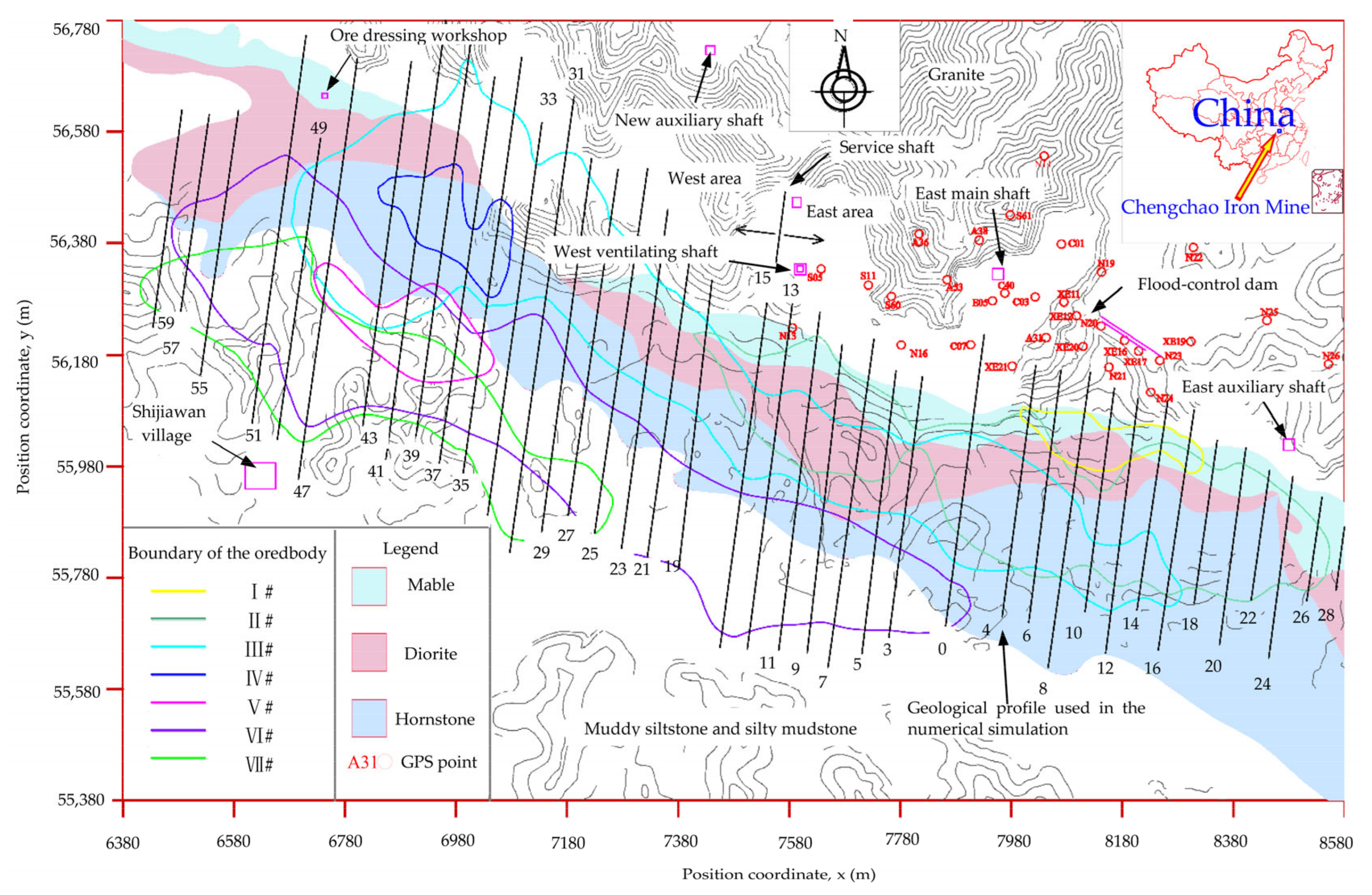
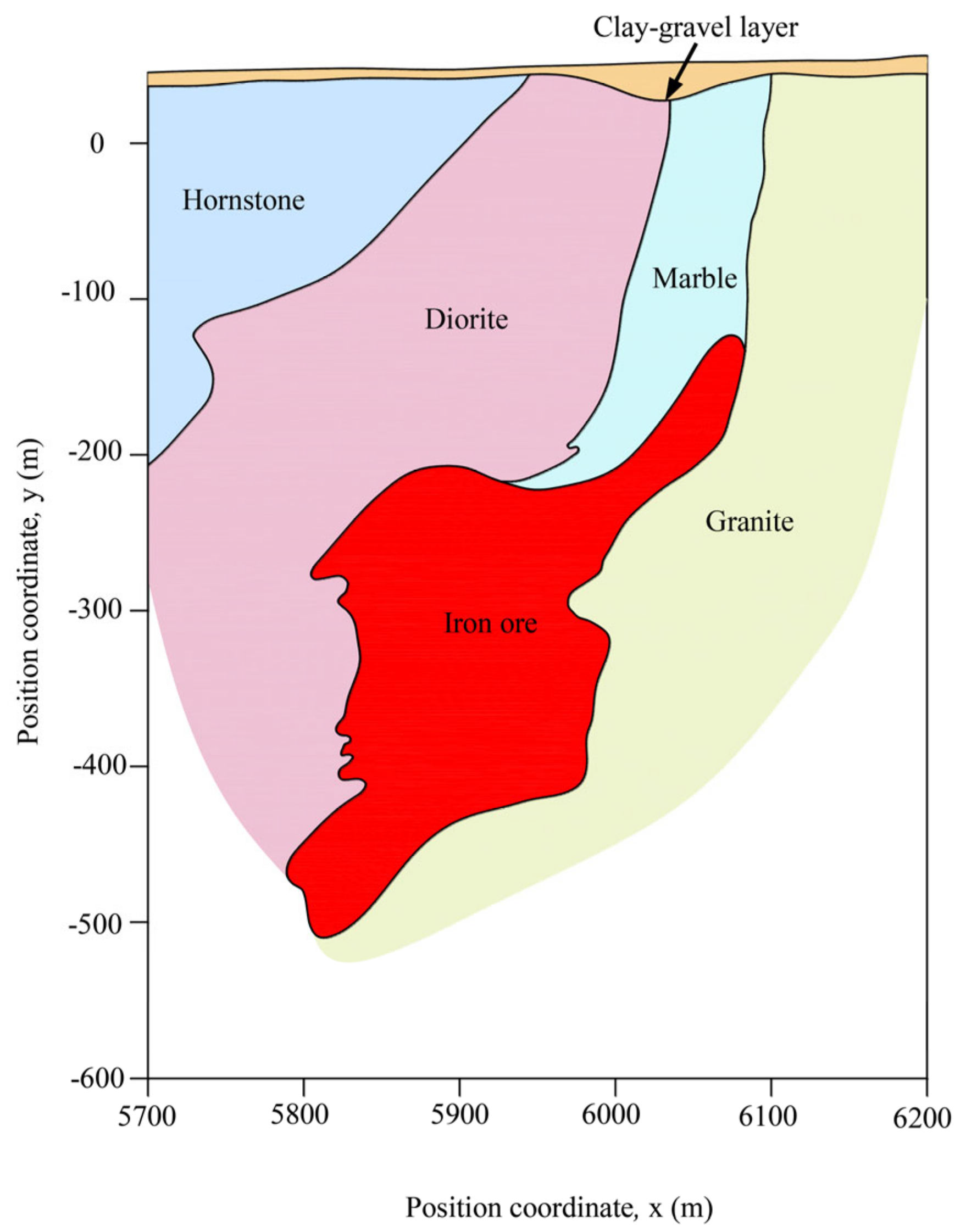
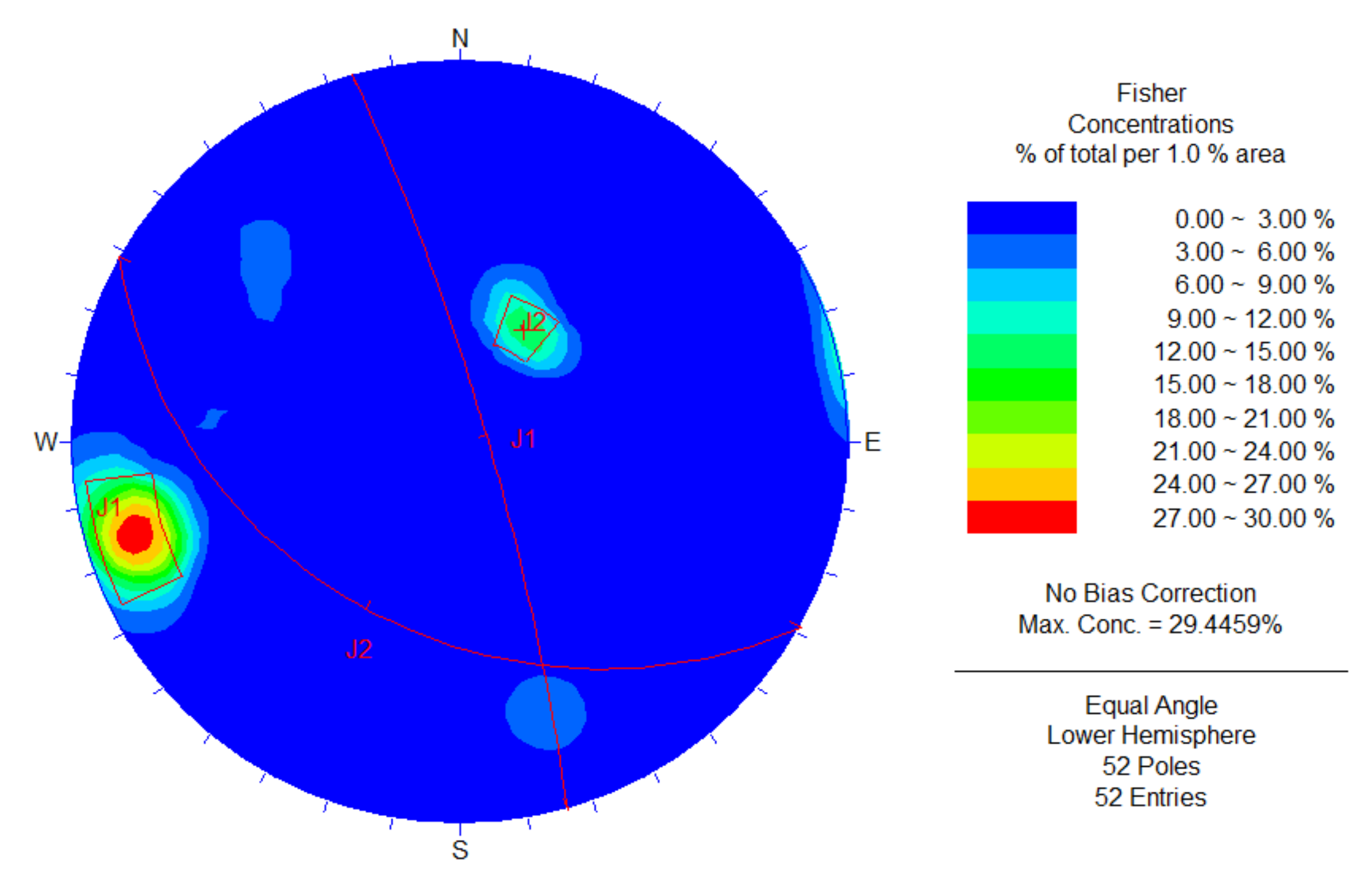
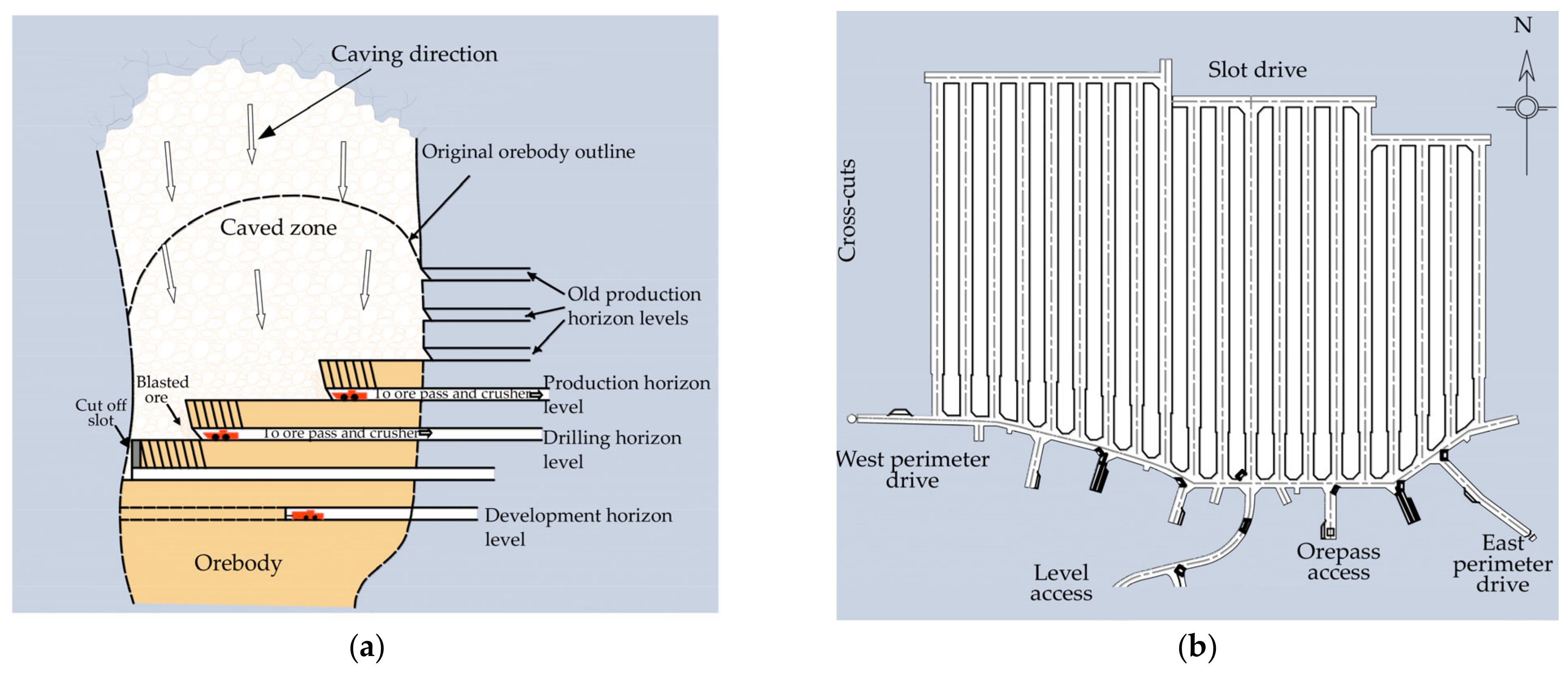

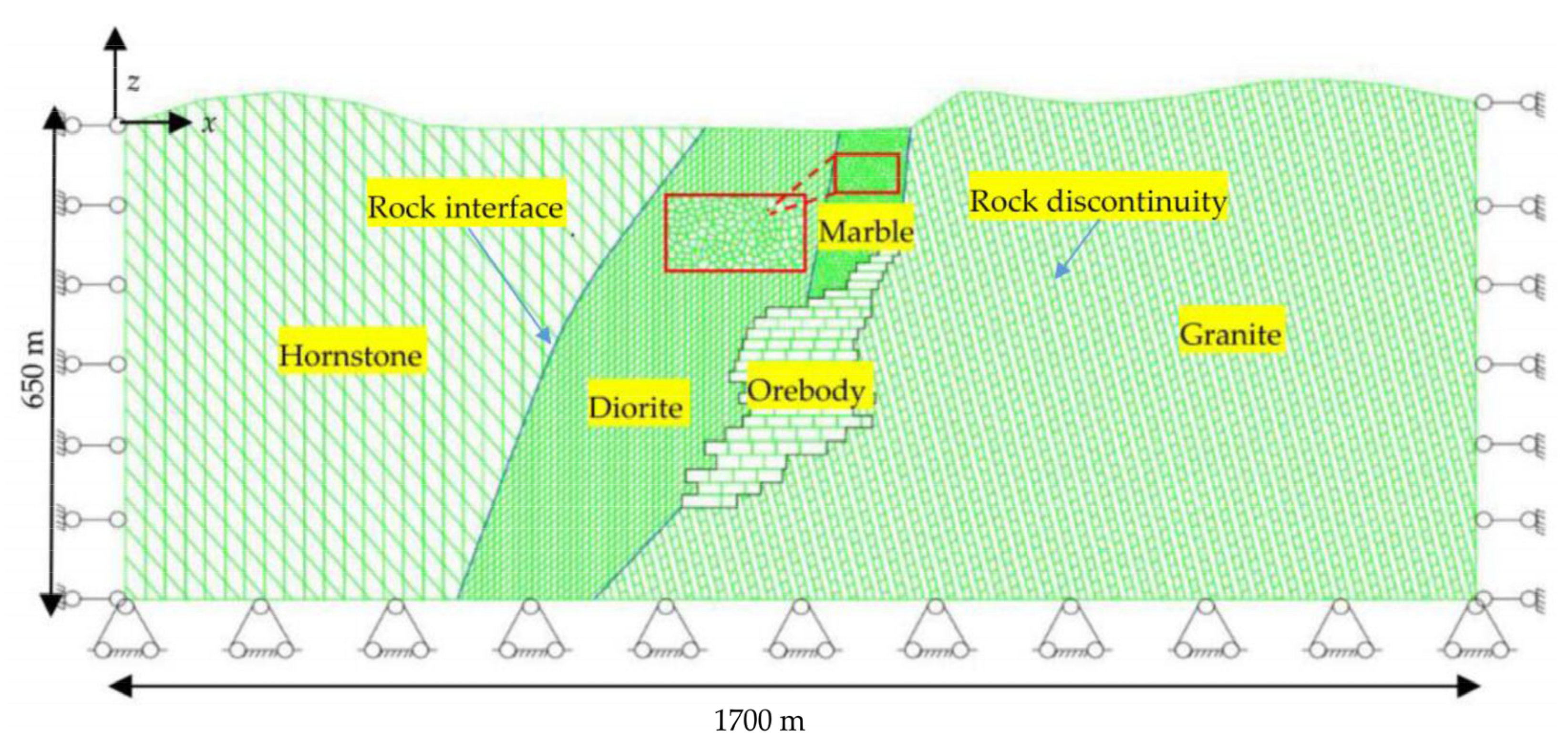

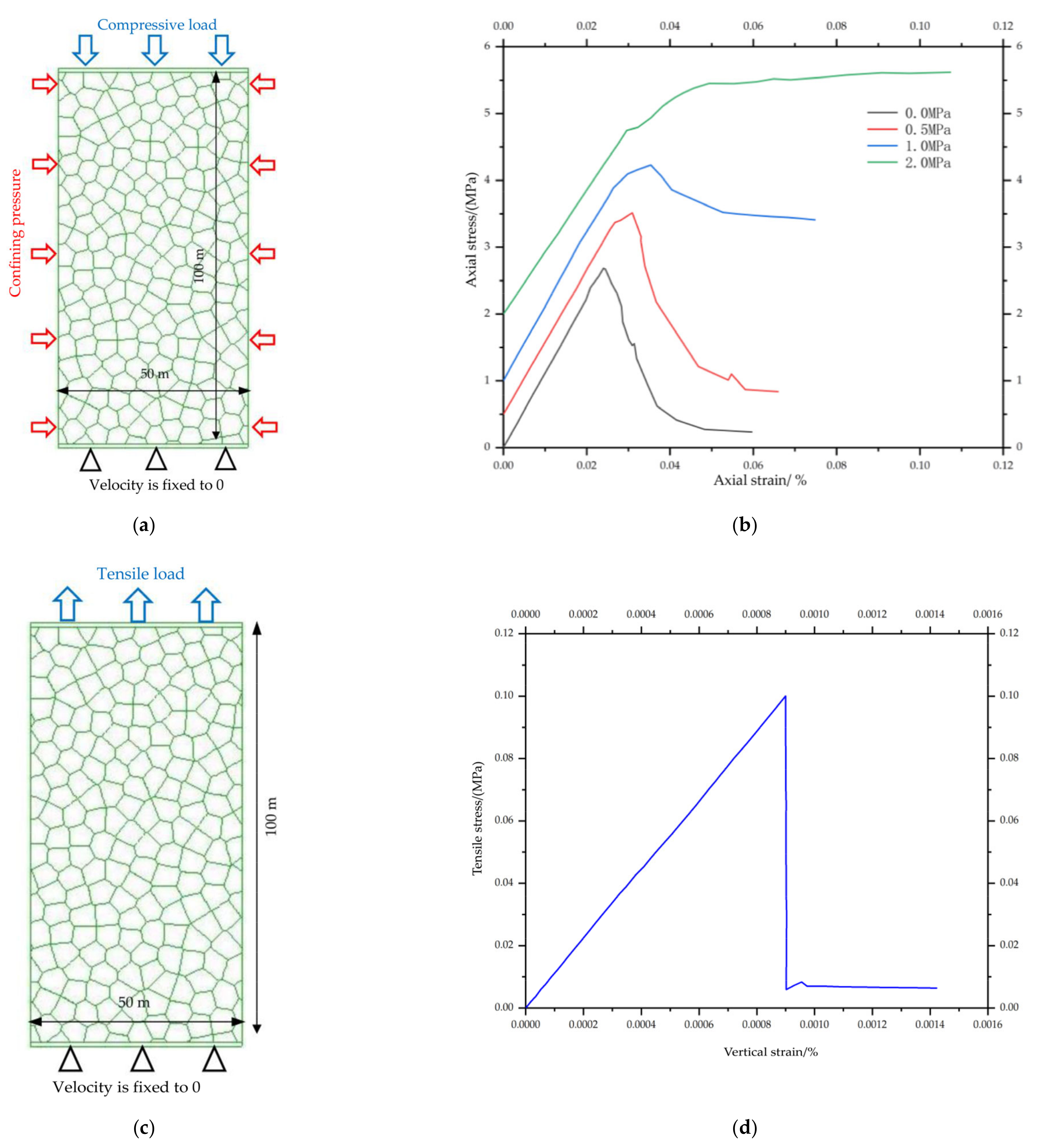
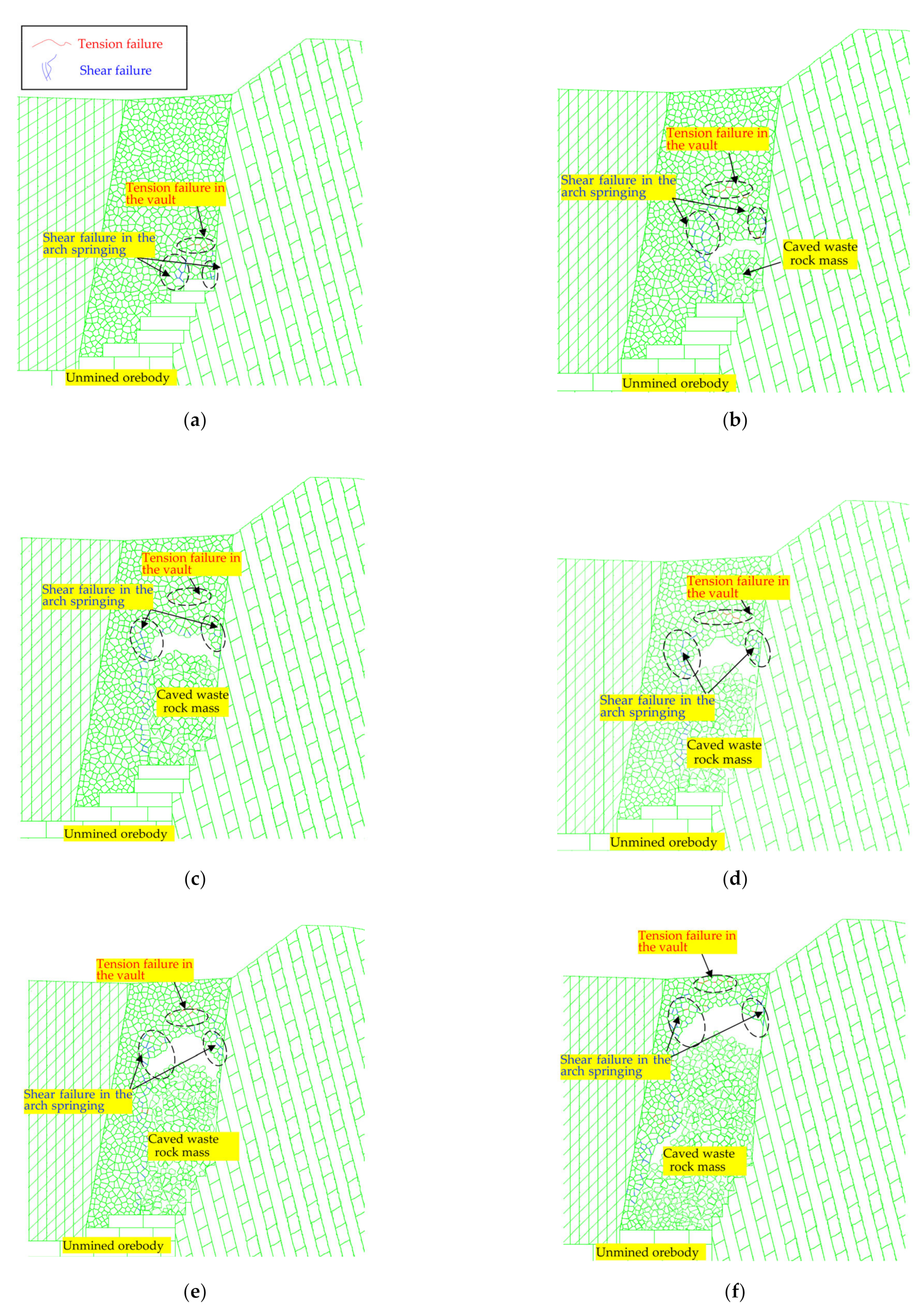
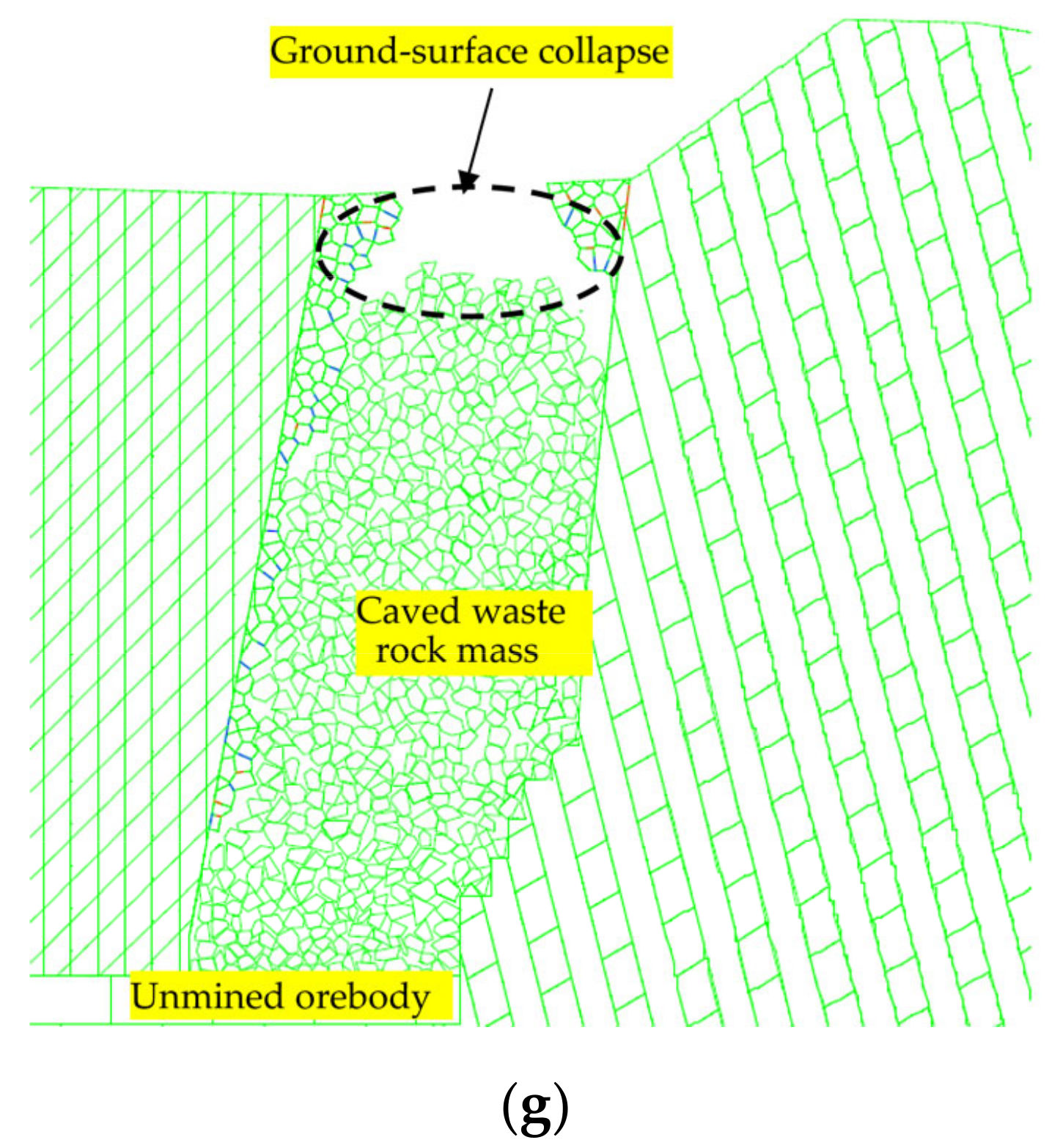
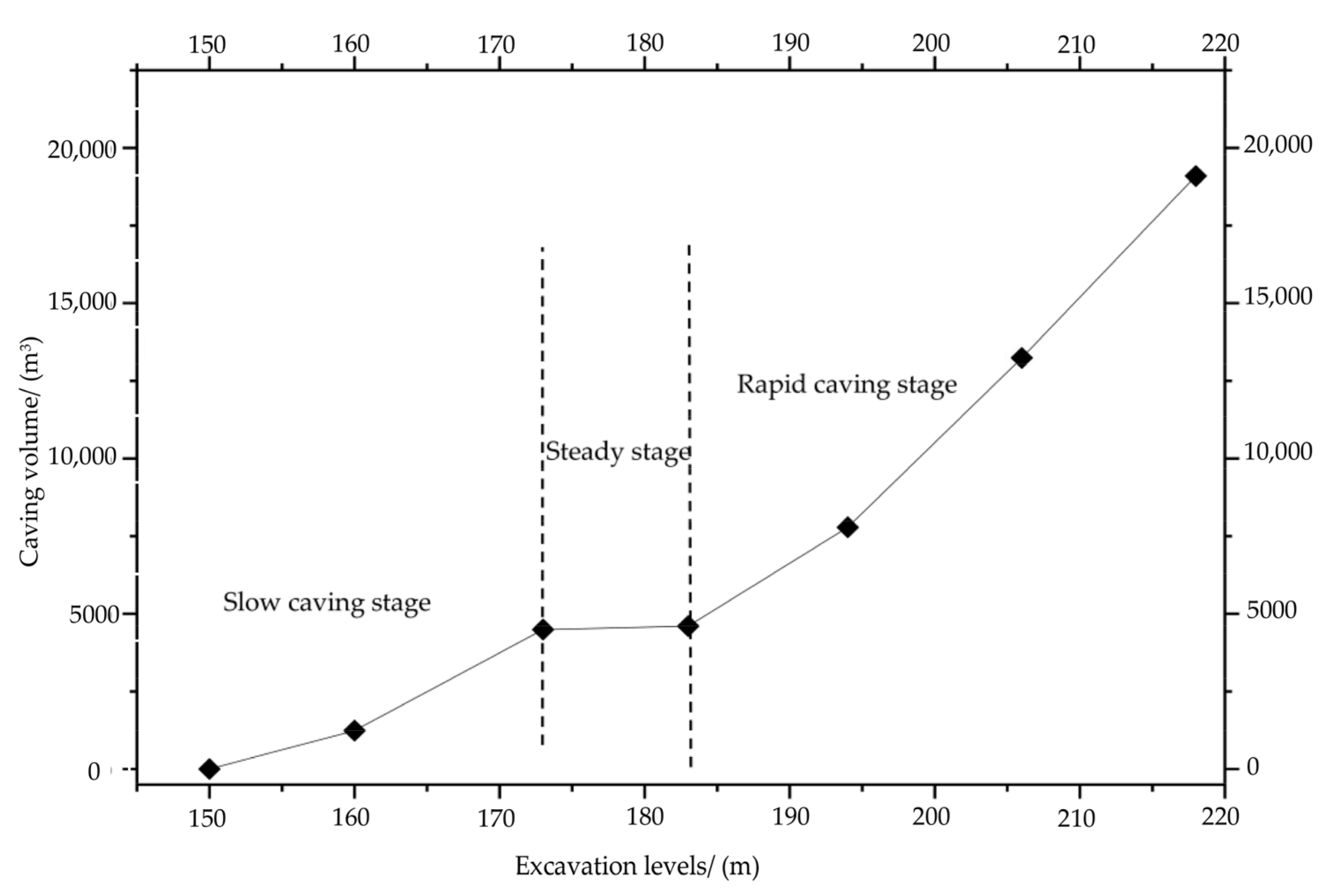
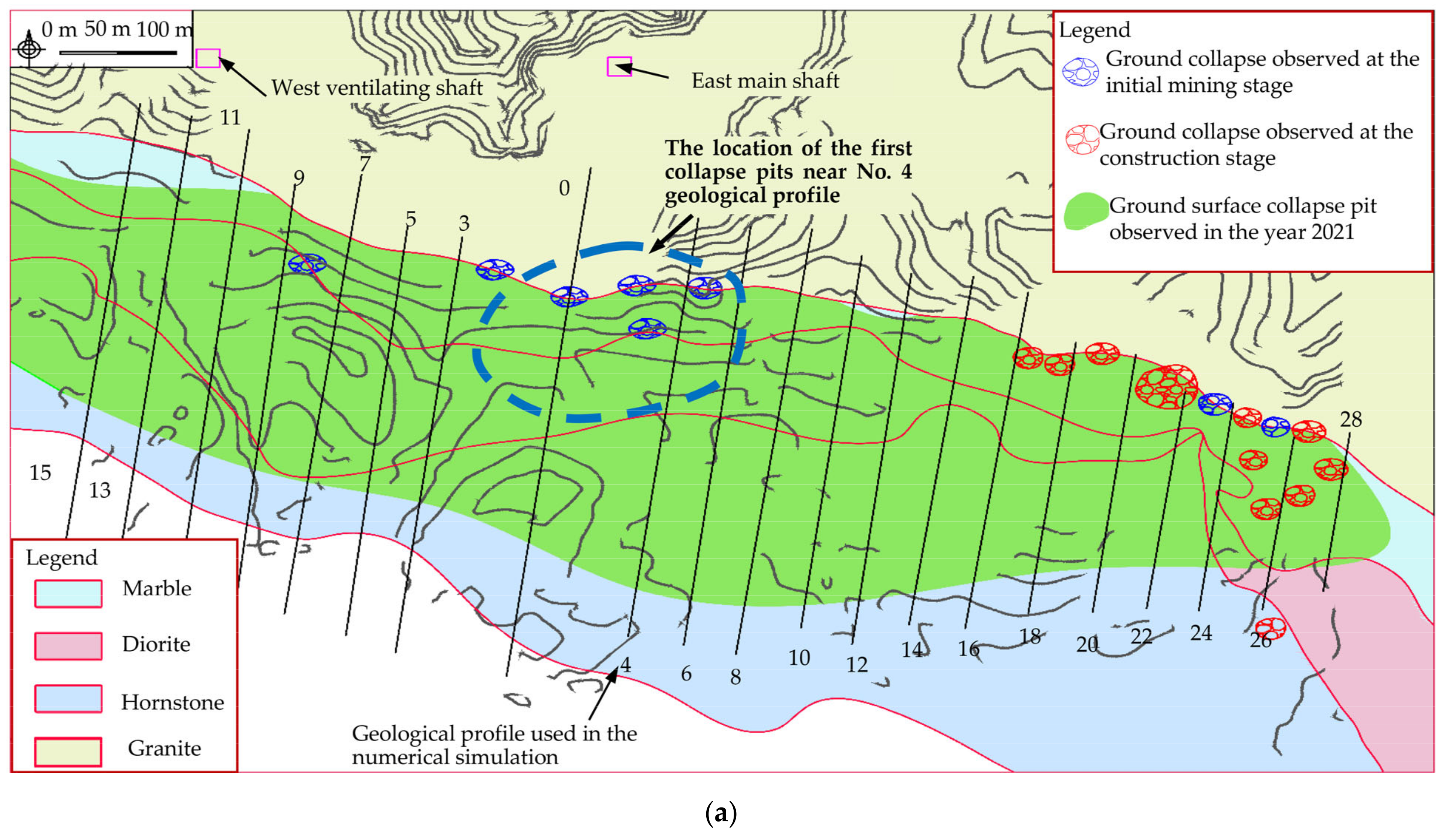
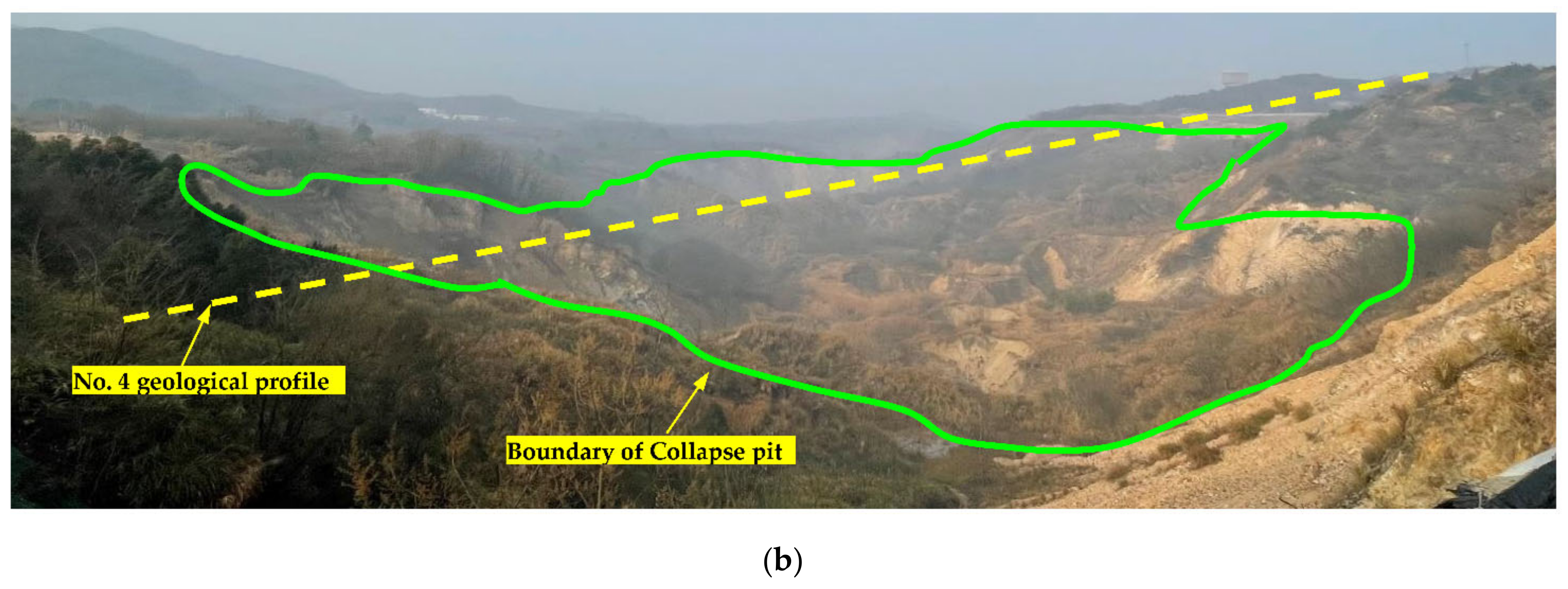
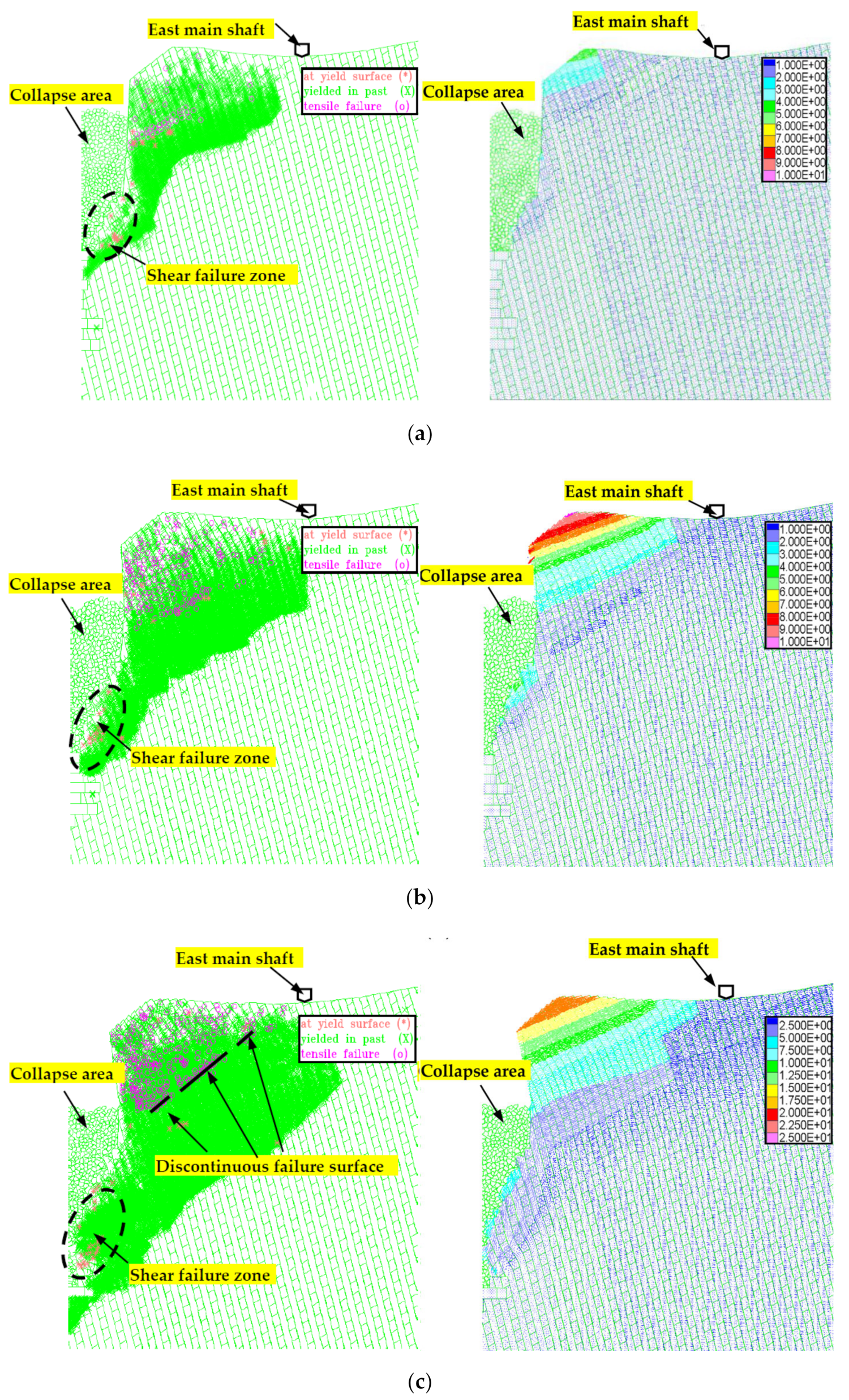
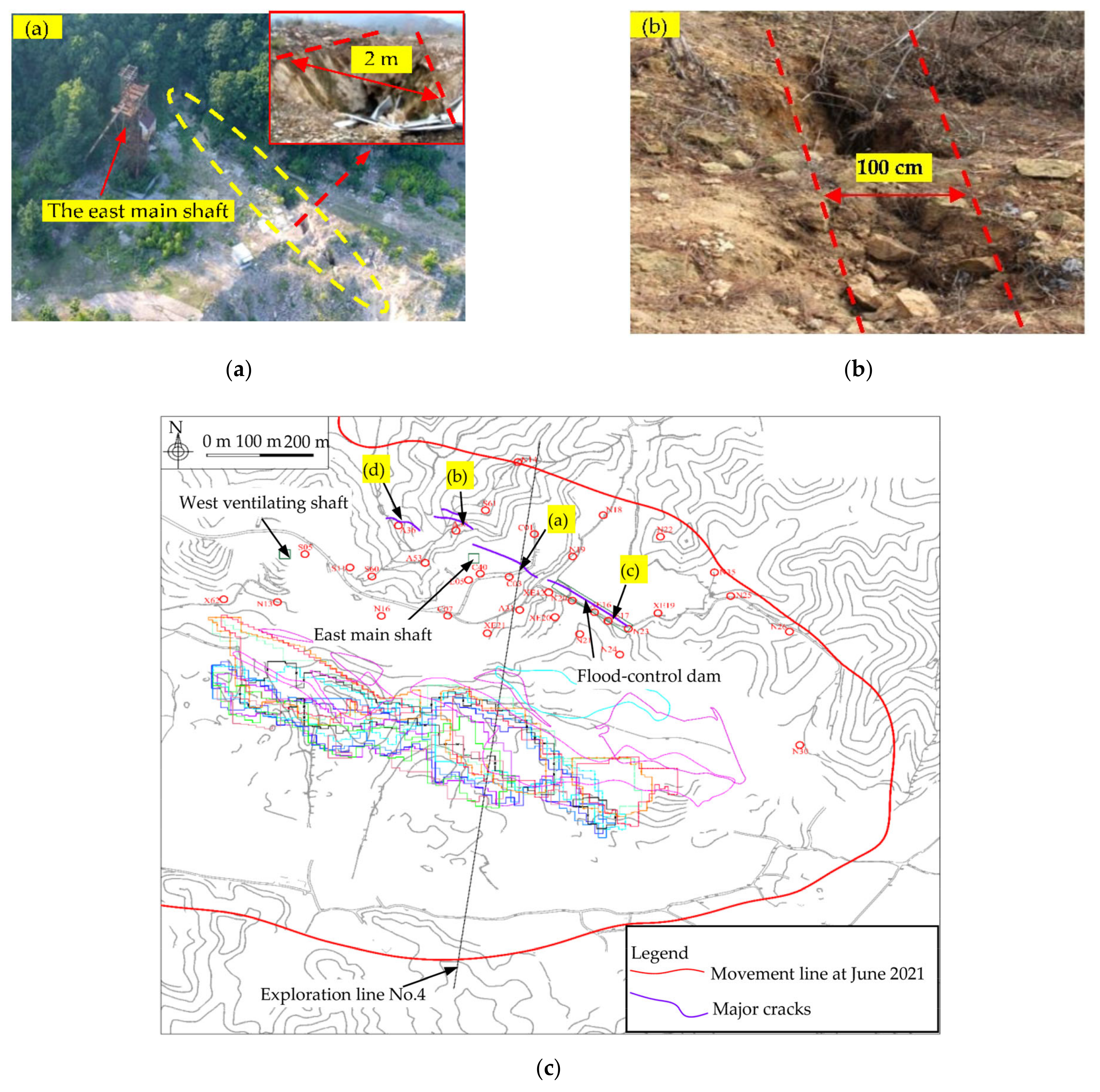
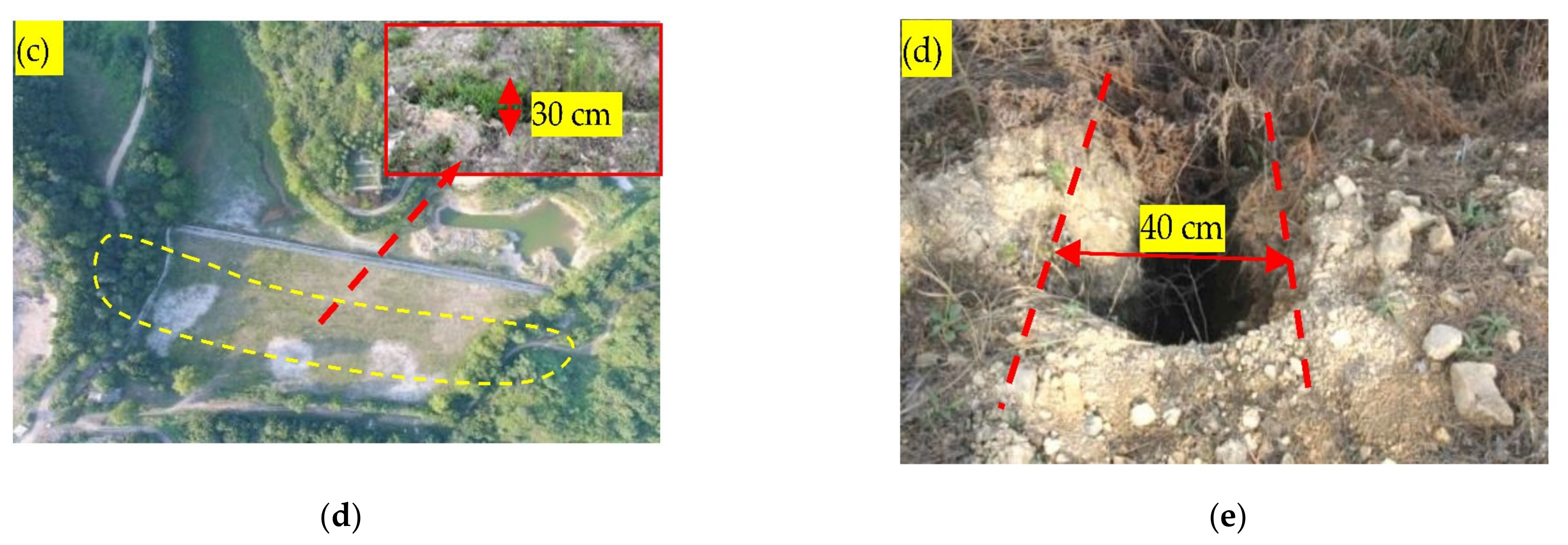

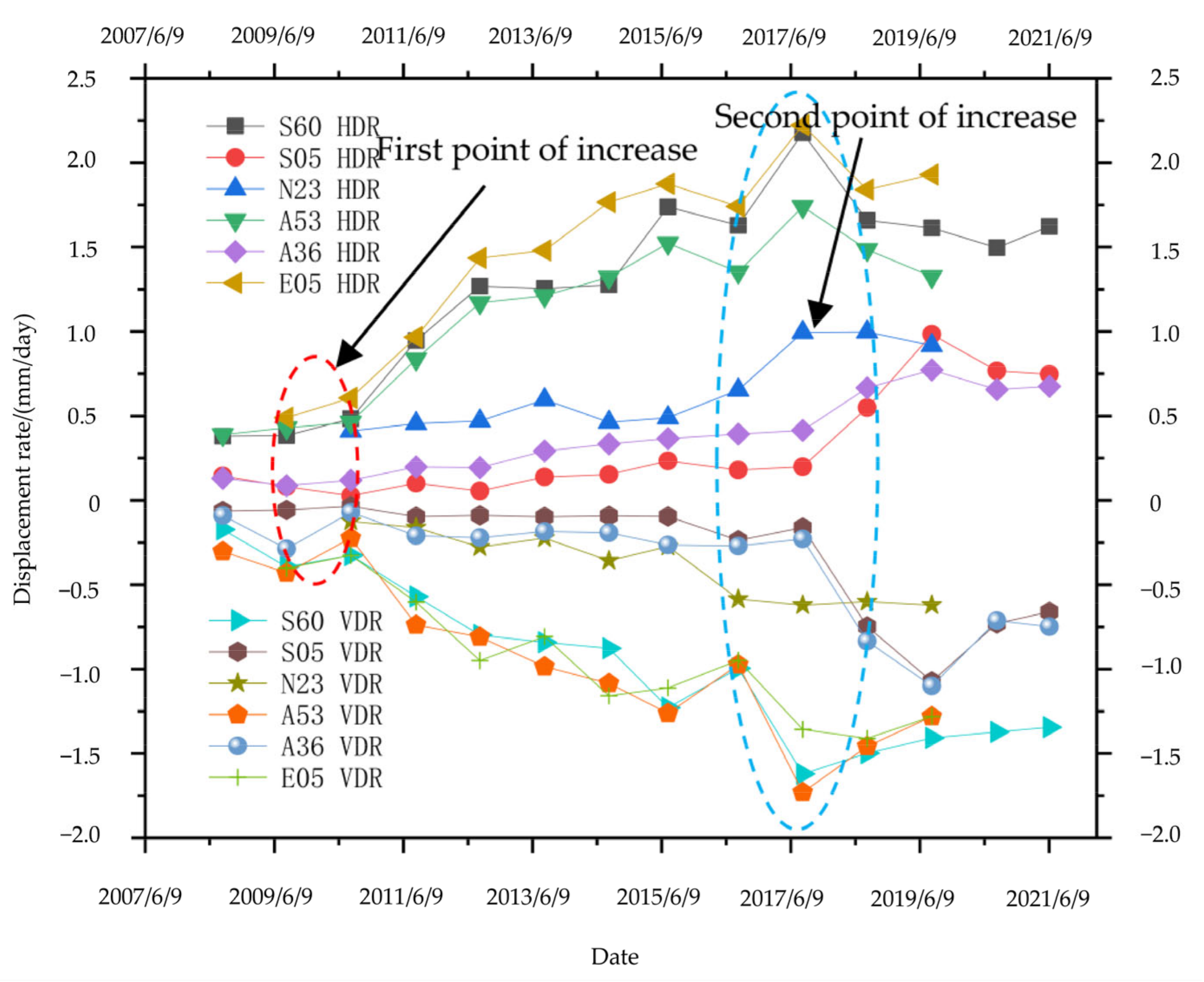

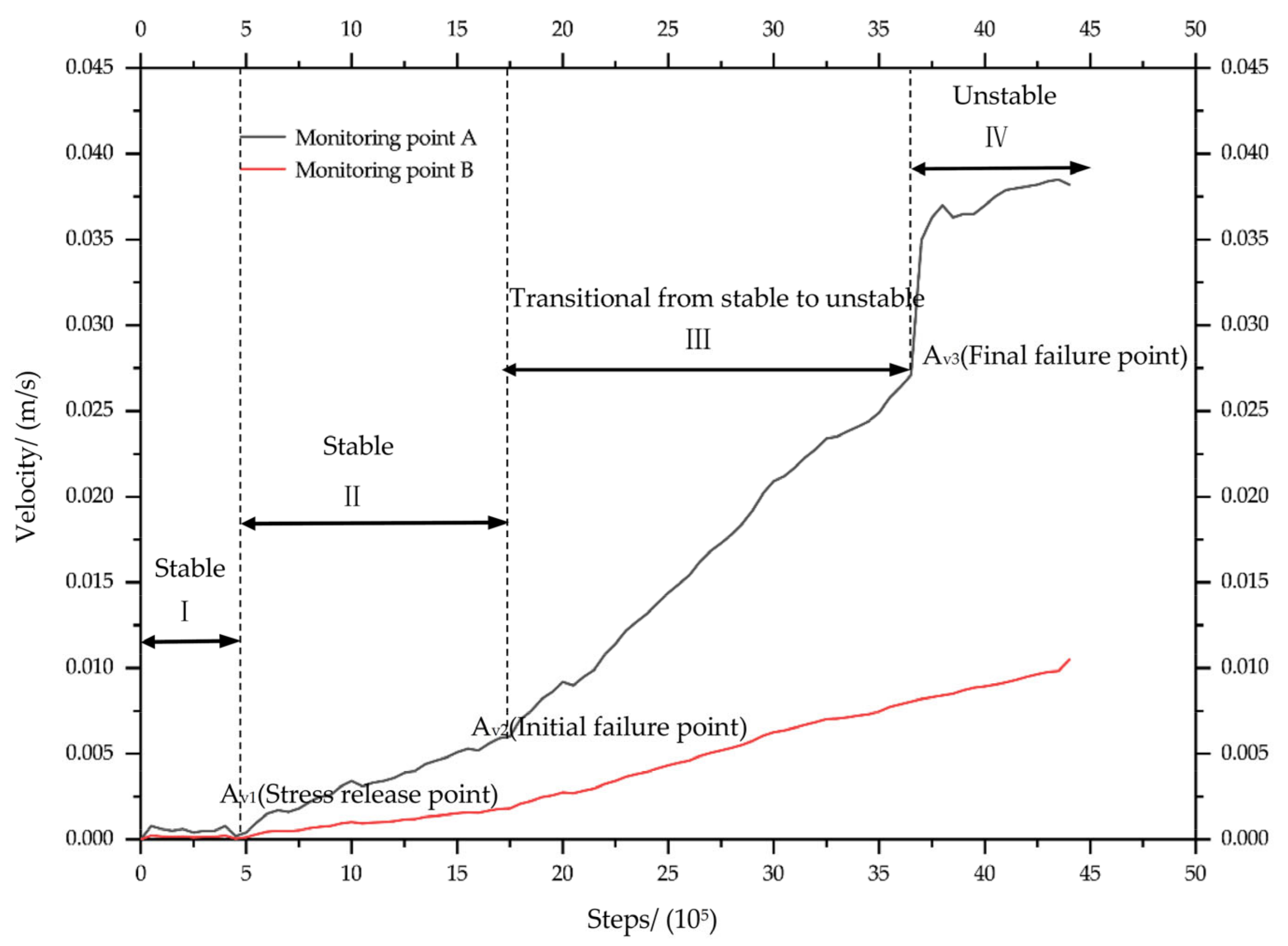
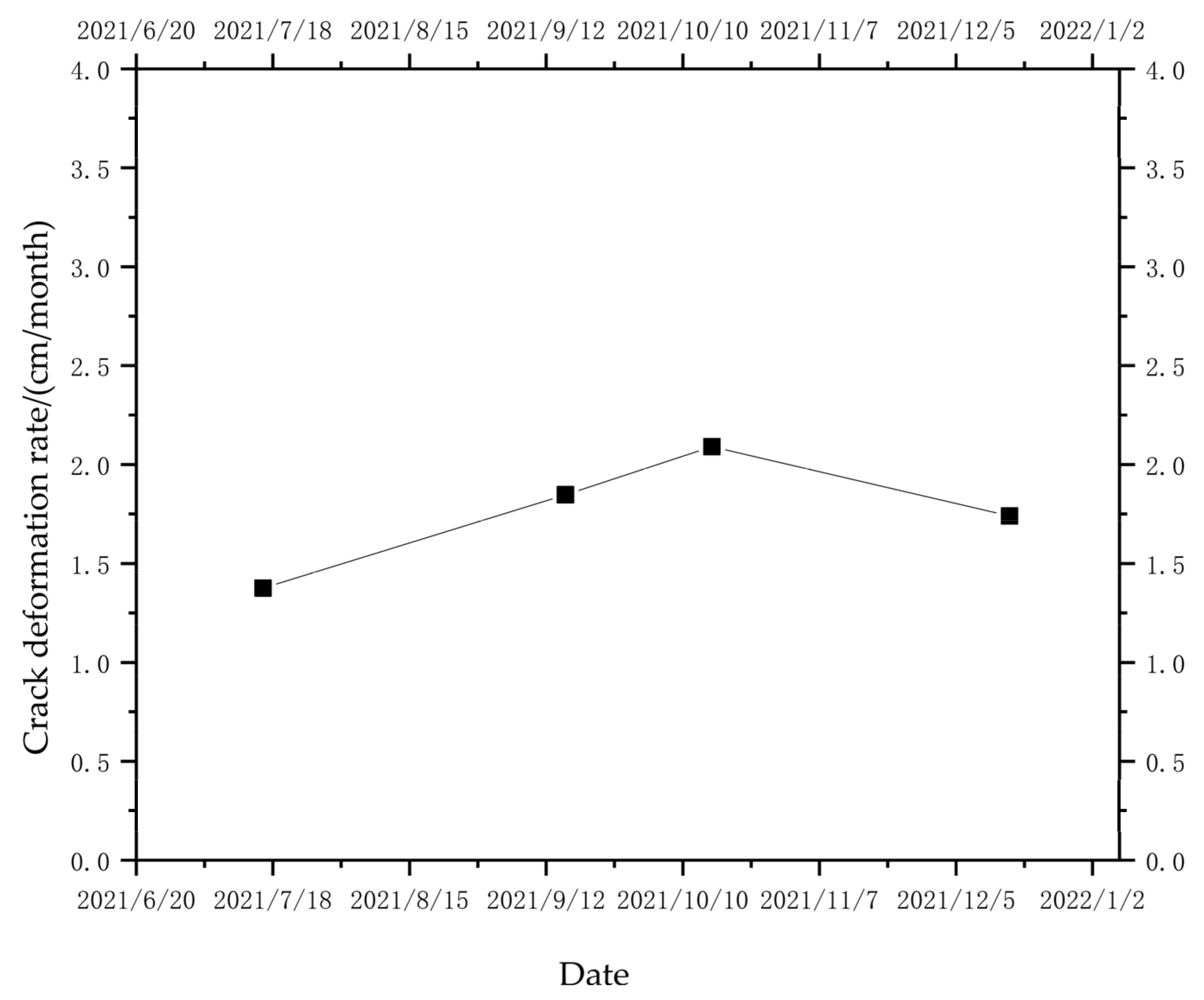

| Mining Level (m) | Mining Date | Orebody Number | Mining Scope (Exploration Line Numbers) | ||
|---|---|---|---|---|---|
| Start | End | Beginning | Ending | ||
| −16.0 | −96.0 | 1969 | 1978 | I,II | 4 to 16; 20 to 26 |
| −106.0 | −150.0 | 1979 | 1984 | II | 10 to 24 |
| −160.0 | −206.0 | 1984 | 1990 | II | 9 to 22 |
| −218.0 | −260.0 | 1990 | 1997 | II | 11 to 22 |
| −260.0 | −302.0 | 1998 | 2002 | II | 13 to 22 |
| −302.0 | −358.0 | 2002 | 2008/07 | III | 15 to 16 |
| −358.0 | −375.0 | 2007/05 | 2012/02 | III | 15 to 16 |
| −375.0 | −393.0 | 2009/05 | 2013/12 | III | 15 to 16 |
| −393.0 | −410.5 | 2012/03 | 2017/03 | III | 15 to 14 |
| −410.5 | −430.0 | 2014/07 | 2018/07 | III | 15 to 12 |
| −430.0 | −447.5 | 2016/06 | 2018/08 | III | 15 to 10 |
| −447.5 | −463.0 | 2018/11 | - | - | - |
| −463.0 | −480.0 | 2019/10 | - | - | - |
| Levels (m) | Corresponding Steps in the Numerical Model | ||||||||||||||||||
|---|---|---|---|---|---|---|---|---|---|---|---|---|---|---|---|---|---|---|---|
| 1 | 2 | 3 | 4 | 5 | 6 | 7 | 8 | 9 | 10 | 11 | 12 | 13 | 14 | 15 | 16 | 17 | 18 | 19 | |
| 150 | * | ||||||||||||||||||
| 160 | * | ||||||||||||||||||
| 171.5 | * | ||||||||||||||||||
| 183 | * | ||||||||||||||||||
| 194.5 | * | ||||||||||||||||||
| 206 | * | * | |||||||||||||||||
| 218 | * | * | * | ||||||||||||||||
| 232 | * | * | * | * | * | ||||||||||||||
| 246 | * | * | * | * | |||||||||||||||
| — | 20 | 21 | 22 | 23 | 24 | 25 | 26 | 27 | 28 | 29 | 30 | 31 | 32 | 33 | 34 | 35 | 36 | 37 | 38 |
| 246 | * | ||||||||||||||||||
| 260 | * | * | * | * | * | ||||||||||||||
| 274 | * | * | * | * | * | ||||||||||||||
| 288 | * | * | * | * | * | ||||||||||||||
| 302 | * | * | * | ||||||||||||||||
| — | 39 | 40 | 41 | 42 | 43 | 44 | 45 | 46 | 47 | 48 | 49 | 50 | 51 | 52 | 53 | 54 | 55 | 56 | 57 |
| 302 | * | * | |||||||||||||||||
| 316 | * | * | * | * | * | ||||||||||||||
| 330 | * | * | * | * | * | ||||||||||||||
| 344 | * | * | * | * | * | * | |||||||||||||
| 358 | * | ||||||||||||||||||
| — | 58 | 59 | 60 | 61 | 62 | 63 | 64 | 65 | 66 | 67 | 68 | 69 | 70 | 71 | 72 | 73 | 74 | 75 | 76 |
| 358 | * | * | * | ||||||||||||||||
| 375.5 | * | * | * | * | * | * | |||||||||||||
| 393 | * | * | * | * | * | ||||||||||||||
| 410.5 | * | * | * | * | * | ||||||||||||||
| — | 77 | 78 | 79 | 80 | 81 | 82 | 83 | 84 | 85 | 86 | |||||||||
| 428 | * | * | * | ||||||||||||||||
| 445.5 | * | * | * | * | |||||||||||||||
| 463 | * | * | |||||||||||||||||
| 480 | * | ||||||||||||||||||
| Lithology | Density (kg/m3) | Deformation Modulus (GPa) | Poisson’s Ratio (GPa) | Cohesion (MPa) | Tensile Strength (MPa) | Friction Angle (°) | Dilation Angle (°) |
|---|---|---|---|---|---|---|---|
| Granite | 2600.00 | 16.09 | 0.22 | 0.80 | 0.16 | 30.20 | 0 |
| Marble | 2700.00 | 12.05 | 0.28 | 0.30 | 0.10 | 27.00 | 0 |
| Hornstone | 2600.00 | 22.50 | 0.25 | 1.84 | 0.18 | 31.80 | 0 |
| Diorite | 2630.00 | 25.31 | 0.26 | 0.80 | 0.16 | 31.00 | 0 |
| Ore body | 3923.00 | 22.41 | 0.21 | 2.48 | 0.25 | 38.10 | 0 |
| Lithology | Density (kg/m3) | Bulk Modulus (GPa) | Shear Modulus (GPa) | Cohesion (MPa) | Tensile Strength (MPa) | Friction Angle (°) | Dilation Angle (°) |
|---|---|---|---|---|---|---|---|
| Granite | 2600.00 | 8.38 | 6.82 | 0.80 | 0.16 | 30.20 | 0 |
| Marble | 2700.00 | 8.45 | 4.36 | 0.30 | 0.10 | 27.00 | 0 |
| Hornstone | 2600.00 | 15.00 | 9.00 | 1.84 | 0.18 | 31.80 | 0 |
| Diorite | 2630.00 | 18.00 | 10.00 | 0.80 | 0.16 | 31.00 | 0 |
| Ore body | 3923.00 | 12.90 | 9.26 | 2.48 | 0.25 | 38.10 | 0 |
| No. | Discontinuity Type | Normal Stiffness (GPa/m) | Shear Stiffness (GPa/m) | Friction Angle (°) | Cohesion (MPa) | Tensile Strength (MPa) | Residual Cohesion (MPa) |
|---|---|---|---|---|---|---|---|
| I | Rock interface | 10.0 | 5.1 | 30 | 0.2 | 0.1 | 0.1 |
| II | Rock discontinuity | 24.0 | 12.4 | 30 | 0.4 | 0.1 | 0.2 |
| Monitoring Point | Horizontal Deformation (March 2012 to March 2017) | Error (cm) | Percentage Error (%) | |
|---|---|---|---|---|
| Calculated Value (cm) | Monitored Value (cm) | |||
| A31 | 360.78 | 397.77 | 36.99 | 9.30 |
| C03 | 102.34 | 119.23 | 16.89 | 14.2 |
| Voronoi Block Size (m) | Block Properties | Contact Properties | ||||||
|---|---|---|---|---|---|---|---|---|
| Unit Weight (kN/m3) | Bulk Moduli (GPa) | Shear Moduli (GPa) | Normal Stiffness (GPa/m) | Shear Stiffness (GPa/m) | Friction Angle (°) | Cohesion (MPa) | Tensile Strength (MPa) | |
| 5 | 27.0 | 8.45 | 4.36 | 14.30 | 5.58 | 27.20 | 0.38 | 0.08 |
Publisher’s Note: MDPI stays neutral with regard to jurisdictional claims in published maps and institutional affiliations. |
© 2022 by the authors. Licensee MDPI, Basel, Switzerland. This article is an open access article distributed under the terms and conditions of the Creative Commons Attribution (CC BY) license (https://creativecommons.org/licenses/by/4.0/).
Share and Cite
Liu, X.; Chen, C.; Liu, X.; Xia, K.; Wang, T. Investigation of the Deformation Failure Occurring When Extracting Minerals via Underground Mining: A Case Study. Minerals 2022, 12, 1025. https://doi.org/10.3390/min12081025
Liu X, Chen C, Liu X, Xia K, Wang T. Investigation of the Deformation Failure Occurring When Extracting Minerals via Underground Mining: A Case Study. Minerals. 2022; 12(8):1025. https://doi.org/10.3390/min12081025
Chicago/Turabian StyleLiu, Xuanting, Congxin Chen, Xiumin Liu, Kaizong Xia, and Tianlong Wang. 2022. "Investigation of the Deformation Failure Occurring When Extracting Minerals via Underground Mining: A Case Study" Minerals 12, no. 8: 1025. https://doi.org/10.3390/min12081025
APA StyleLiu, X., Chen, C., Liu, X., Xia, K., & Wang, T. (2022). Investigation of the Deformation Failure Occurring When Extracting Minerals via Underground Mining: A Case Study. Minerals, 12(8), 1025. https://doi.org/10.3390/min12081025






